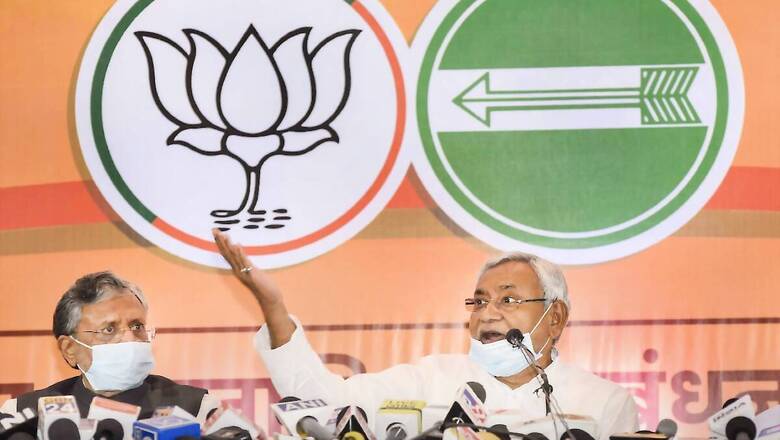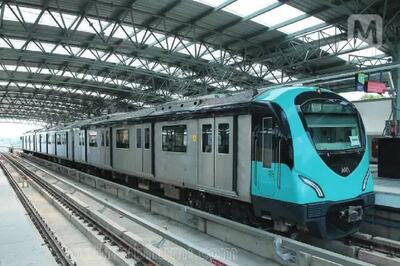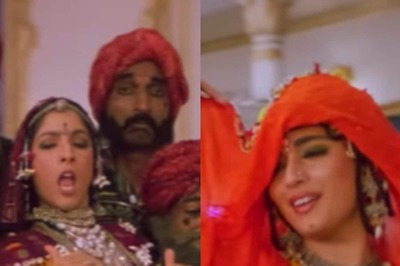
views
Comparison may be a smart marketing strategy, but in politics it’s used when the story of ‘change’ and ‘hope’ loses its charm. And when the comparison is not among equals, both in times and ideas, it gives rise to fallacies. Bihar today is witnessing a similar comparison — 15 years of Nitish Kumar vs 15 years of Lalu Yadav.
“Aaya toh baar baar sandesa ameer ka, humse magar na ho sakaa sauda zameer ka” (Was offered the riches but couldn’t trade in my conscience). It was a moment of political reckoning for Nitish Kumar as he famously quoted this couplet and snapped ties with the BJP after Narendra Modi was announced as the campaign committee chairman in the BJP’s national executive in Goa in June 2013. He embarked on a journey that would for a brief while project him as a potential PM candidate of the then opposition. The rest as we know is history.
Sociologist Manisha Priyam questions the comparison and suggests that by doing this, the JD-U is putting itself on an equal platform with the RJD. “It’s a non-comparator because Nitish has a good governance image. The question that will be asked is why does he need to compare himself with 15 years of Lalu anyway? Why does he need to compare with an RJD that’s being led by a young politician, Tejashwi Yadav. What’s the compulsion to make this comparison? Maybe it was good to do it in 2005, but why now?”
So, is Nitish Kumar on the defensive as he tries to sell fear of ‘jungle raj’ third time over? Does he not have new themes for a better Bihar? Nitish has unveiled the second part of his ‘7 Nishchay’ scheme, a set of pre-poll promises that led to Lok Janshakti Party (LJP) chief Chirag Paswan raising the flag of rebellion and exiting the National Democratic Alliance (NDA) in Bihar.
In 2015, Bihar saw a political experiment in the Mahagathbandhan when arch-rivals but friends of the socialist movement, Nitish Kumar and Lalu Yadav, came together. Nitish was the face and Lalu the social engineering force. The ‘jungle raj’ tag was forgotten and Nitish was vociferous in reminding people that this alliance was here to stay. Born out of compulsion, this was a coalition of opportunism.
Nitish had run the government with the BJP from 2005 till 2013. Those were the years when Bihar looked buoyant, and Nitish the beacon of hope riding high on Bihari pride. The state witnessed many firsts with 50 per cent reservation for women in panchayats, reservation for economically backward classes (EBCs), speedy trials and convictions. The faith in rule of law was restored. The people of Bihar gave him an even bigger mandate in 2010. The NDA won 206 seats in the 243-member Bihar assembly.
The Rashtriya Janata Dal (RJD) didn’t get enough seats to even stake claim for the Leader of Opposition position. The next few years would further establish Nitish’s political integrity, squeaky clean image and position him as ‘sushasan babu’ (man of good governance).
But then came the era of political turmoil, which impacted his governance too.
According to data sourced from the Bihar government’s Department of Home, the number of kidnappings in the state has gone up by almost five times. Cases of reported rapes in the state increased 1.5 times during Nitish Kumar’s third term, as compared to his first five years as CM. The state registered a constant increase in incidents of murder, dacoity, robbery, burglary and theft in 2019 as compared to 2005.
Bihar saw an education revolution under Nitish Kumar. Girls on bicycles on the roads of Bihar was the defining image. Enrolment rates among girls spiked in primary and upper primary schools by close to 20% since 2005-06.
However, in 2016-2017, Bihar recorded the highest percentage of dropouts in primary education at 38.69%, much worse than the national average of 26.96%. In 2018, Muzaffarpur shelter home scandal came to light where cases of sexual abuse, rape and torture were reported. In a medical examination, it was found that 34 out of 42 inmates living in the shelter home were sexually abused.
Nitish Kumar’s handling of the incident drew sharp criticism from the Supreme Court. In another incident at Kasturba Gandhi Balika Vidyalaya in Triveniganj, 250 km from Patna, a mob thrashed a group of girls inside their school premises when they resisted harassment by boys. It showed Bihar was slipping between the fault lines.
Sanjay Kumar, director of the Centre for the Study of Developing Societies (CSDS), says, “Nitish Kumar’s aura of ‘Vikas Purush’ has been much bigger compared to the real achievements. In order to cover up the reality, you have to compare it to someone who has done much less; so the tool of comparison is being used by Nitish Kumar. The first 5-7 years of Nitish were fantastic; there is evidence for that. His 2010 victory was the biggest victory because of the work done by him between 2005 and 2010.”
“In 2010, the NDA led the RJD by 14-15% votes. That’s a big victory, similar to Lalu’s victory of 1995 when he had just completed five years as chief minister. He led the NDA by 13% votes. So the first five years were much better,” Kumar adds.
In 2019, Bihar saw floods and the images of Bihar’s deputy CM Sushil Modi being evacuated from his Patna home were flashed across national news channels. That symbolised how the state’s poor urban infrastructure, poor drainage system were a grim reality. According to the 2011 Census, the rate of urbanisation was 11.3% in Bihar, compared to the national average of 31.2%.
Bihar today doesn’t have any showcase city. During the fifth annual cleanliness survey of the country, Bihar continued to be at the bottom of the list with the six dirtiest cities coming from the state. The coronavirus pandemic made matters worse. Nitish Kumar was the only chief minister who raked up iron gates at the state border and refused entry to returning migrants in their home state. While the CMs of other states, including neighbouring Uttar Pradesh, sent buses to ferry its people back home, Nitish Kumar abandoned his own.
Today, the state is seeing a fresh challenge with its migrants returning home, adding to unemployment. The Centre for Monitoring Indian Economy said that the unemployment rate in Bihar increased by almost three times between 2011-12 and 2018-19. The National Sample Survey Office (NSSO) data revealed that unemployment among women in 2011-12 spiked by almost 30% when compared with 2004-2005.
In 2005, when he first embarked on his yatra to Champaran ahead of coming to power, Nitish carefully chose Mahatma Gandhi’s place of Satyagraha. It was about connecting to the people of the state with a moral appeal. For all of 15 years, Nitish Kumar has been a leader who has had no challenger in the state; the only challenger was in the 2014 Lok Sabha elections. Today, the challengers to Nitish Kumar in Bihar are the sons of his JP movement friends.
If 2005 was about the pride of Bihar, in 2010 Nitish transformed himself into a Sushasan Babu, and in 2015 he was the challenger to BJP. If a comparison with 15 years of RJD is all he has to offer in 2020, he would appear as a pale shadow of his own past to many.
Read all the Latest News and Breaking News here



















Comments
0 comment